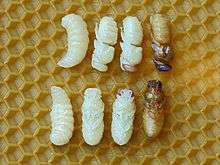Honey bee life cycle
The honey bee life cycle, here referring exclusively to the domesticated Western honey bee, depends greatly on their social structure.

Colony life
Unlike a bumble bee colony or a paper wasp colony, the life of a honey bee colony is perennial. The three types of honey bees in a hive are: queens (egg-producers), workers (non-reproducing females), and drones (males whose main duty is to find and mate with a queen). Thus honey bees have two sexes, male and female, and the female bee has two castes, queen and worker. The queen lays eggs singly in cells of the comb. Larvae hatch from eggs in three to four days. They are then fed by worker bees and develop through several stages in the cells. Cells are capped by worker bees when the larva pupates. Queens and drones are larger than workers, so require larger cells to develop. A colony may typically consist of tens of thousands of individuals.
While some colonies live in hives provided by humans, so-called "wild" colonies (although all honey bees remain wild, even when cultivated and managed by humans) typically prefer a nest site that is clean, dry, protected from the weather, about 20 liters in volume with a 4- to 6-cm2 entrance about 3 m above the ground, and preferably facing south or south-east (in the Northern Hemisphere) or north or north-east (in the Southern Hemisphere).
Development

Development from egg to emerging bee varies among queens, workers, and drones. Queens emerge from their cells in 15-16 days, workers in 21 days, and drones in 24 days. Only one queen is usually present in a hive. New virgin queens develop in enlarged cells through differential feeding of royal jelly by workers. When the existing queen ages or dies or the colony becomes very large, a new queen is raised by the worker bees. The virgin queen takes one or several nuptial flights, and once she is established, starts laying eggs in A fertile queen is able to lay fertilized or unfertilized eggs. Each unfertilized egg contains a unique combination of 50% of the queen's genes[1] and develops into a haploid drone. The fertilized eggs develop into either workers or virgin queens.
The average lifespan of a queen is three to four years; drones usually die upon mating or are expelled from the hive before the winter; and workers may live for a few weeks in the summer and several months in areas with an extended winter.
| Type | Egg | Larva | Cell capped | Pupa | Average developmental period
(Days until emergence) |
Start of fertility | Body length | Hatching weight |
|---|---|---|---|---|---|---|---|---|
| Queen | up to day 3 | up to day 8½ | day 7½ | day 8 until emergence | 16 days | day 23 and up | 18–22 mm | nearly 200 mg |
| Worker | up to day 3 | up to day 9 | day 9 | day 10 until emergence (day 11 or 12 last moult) | 21 days
(range: 18–22 days) |
N/A | 12–15 mm | nearly 100 mg |
| Drone | up to day 3 | up to day 9½ | day 10 | day 10 until emergence | 24 days | about 38 days | 15–17 mm | nearly 200 mg |
The weight progression of the worker egg, larva:

| Days | Developmental state | Weight | Length | Food source |
|---|---|---|---|---|
| 1 | egg | 0.132 mg | 1.2mm | yolk |
| 2 | egg | not listed | yolk | |
| 3 | egg | 0.09 mg | yolk | |
| 4 | larva | not listed | royal jelly | |
| 5 | larva | 3.4 mg | royal jelly | |
| 6 | larva | 33.3 mg | royal jelly/honey and pollen (bee bread) | |
| 7 | larva | 100.1 mg | honey and pollen (bee bread) | |
| 8 | larva | 134.5 mg | honey and pollen (bee bread) | |
| 9 | larva | 155.2 mg | honey and pollen (bee bread) | |
See also
Sources
- ↑ http://members.aol.com/queenb95/genetics.html#anchor1561346
- ↑ Stone, David M. Overview of Bee Biology University of Illinois Laboratory Highschool; web accessed Oct. 2006
- Development of honeybees bee-info.com, accessed Oct 2005
- Stanley E. Flanders (1960). "Caste in the honey bee". Insectes Sociaux. 7 (1): 9–16. doi:10.1007/BF02225754.
- H. Rembold (1964). "Die Kastenentstehung bei der Honigbiene, Apis mellifica L". Naturwissenschaften. 51 (3): 49. doi:10.1007/BF00603442.
- Temporal Polyethism in Bees
External links
- Life cycle information by the FAO